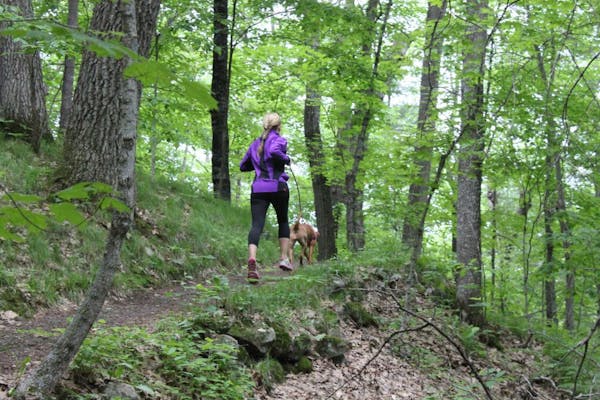The broad-shouldered fish — a carp of considerable vintage — didn't inhale my fly as much as he rolled it around his mouth, a midmorning inspection that, in fly-fishing time, played out far too long.
"Eat it," I said softly under my breath, my feet wedged between the riprap anchoring the west face of Jabs Dike, less than a half-mile as the crow flies from the Minnesota River between Jordan and Chaska.
What I remember most about that morning a year ago was not my line going taut or the Achilles of freshwater fish schooling me and finally breaking me off. It was that I was completely alone and fully immersed in nature, in one of the metro area's fastest-growing regions. Civilization seemed very, very far away.
Welcome to the 2,600-acre Louisville Swamp Unit of the 14,000-acre Minnesota Valley National Wildlife Refuge, an outdoor oasis within a larger outdoor oasis. Hugging the Minnesota River across several counties, cities and townships, Minnesota Valley meanders roughly 70 miles — from Henderson to Bloomington — and is an urban getaway for hikers, bikers, wildlife-watchers, photographers, cross-country skiers, hunters and big-fish-obsessed fly fishers. Simply put, it's a refuge for all seasons.
Established in 1976 to provide habitat for migratory waterfowl and one of the country's largest urban refuges (the visitor center in Bloomington sits in the shadow of the Mall of America and the Minneapolis-St. Paul International Airport), Minnesota Valley is also interspersed with additional "conservation" lands (mostly state and private), forming a near-contiguous "green corridor" of managed landscapes: tall grass prairie, oak savanna and flood plain forest, with various wetlands and fens sprinkled throughout.
"The refuge is respite for people who want to get away from the hustle and bustle of urban life," said Beth Ullenberg, visitor services manager with the U.S. Fish and Wildlife Service at Minnesota Valley. "It's a truly wild place surrounded by urban and suburban development, which makes it rare. For most people, the refuge is place to find solitude and reconnect with nature."
I grew up in Shakopee, along the Minnesota River, my home waters, and have spent countless hours exploring the refuge, especially its Louisville Swamp Unit. On a recent late-afternoon hike there, beneath a blanket of blue ski and temperatures hovering near 75 degrees, the gravel parking lot was lonesome (one car) as I hit the trailhead on what turned out to be a two-hour hike. I wanted to get beyond the pavement, and badly, and the unit's 13 miles of trail allows for just that. In fact, for the uninitiated, you may even get lost. Been there, done that.
A mile into my hike, and to illustrate that everything in nature is constantly becoming, I came to the aforementioned Jabs Dike, which was (shockingly) impassable, thanks to a steady torrent of spring and early-summer rains. No matter. A wader-clad fisherman stood in thigh-high flood water and cast for fish as birds by the hundreds — on the water and in the air — paid him no mind and coexisted peacefully, nature's version of détente.
It's still summer, but shorebirds are already starting to flock up for their mass exodus south. In fact, in the coming weeks, The Swamp will transform into a birder's paradise, with thousands upon thousands (songbirds, raptors, waterfowl, including tundra and trumpeter swans and sandhill cranes, if you like the big birds) resting and feeding before winging south to balmier climes.
My advice: To get up close and personal, bring a spotting scope (which I prefer) or a good pair of binoculars. You won't be sorry.
Minnesota Valley has eight "developed" management units (with trails, parking lots and other infrastructure) and two smaller undeveloped units. Some, but not all, allow for hunting; check Minnesota Valley's website for details: www.fws.gov/refuge/Minnesota_Valley/.
For many, the refuge is a godsend because it provides hunting access for white-tailed deer, turkeys, waterfowl and small game, in a congested and growing region where open space is limited and shrinking rapidly. "The refuge is always open, and that's important for guys like me who don't have access to private land," an archery hunter told me last year, a portable deer stand strapped to his back. "I'm grateful I have a place so close to home."
In high school, my friends and I would occasionally forgo our liberal arts education and hunt ducks on the refuge between Shakopee and Bloomington. We called Minnesota Valley our "open-air classroom," a living museum to learn the ways and means of waterfowling. Believe me. We spent many mornings there and learned plenty.
But if I had my druthers, there's no other wild place in the metro area (or perhaps anywhere) I'd rather spend a day — spring, summer, winter or fall — than Louisville Swamp, hiking amid the oak savanna, a rare ecosystem of scattered oaks above a lush layer of prairie grasses and wildflowers.
If you have freedom on your mind and a need to find solitude in the extreme, a hike through The Swamp will clear your head and reconnect you to nature. And it won't cost you a dime.
Tori J. McCormick is a freelance writer living in Prior Lake. Contact him at torimccormick33@gmail.com.
Star driver Josef Newgarden fights back tears, accepts blame for breaking rules in IndyCar scandal
Seth Lugo throws 7 scoreless innings, leads Royals past Tigers 8-0
Giannis Antetokounmpo ruled out of third game in Bucks-Pacers playoff series

